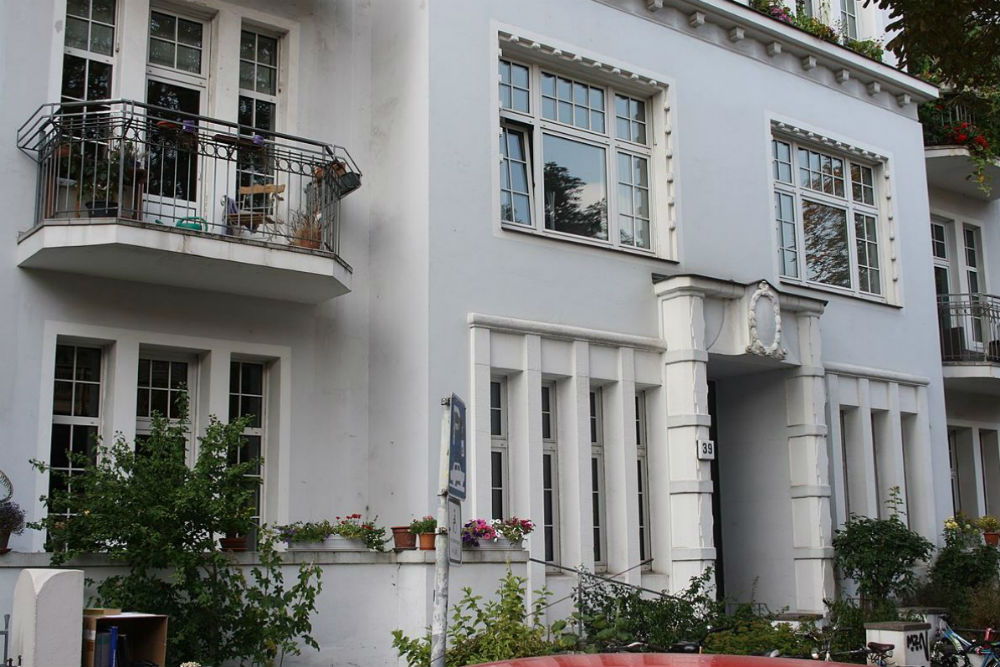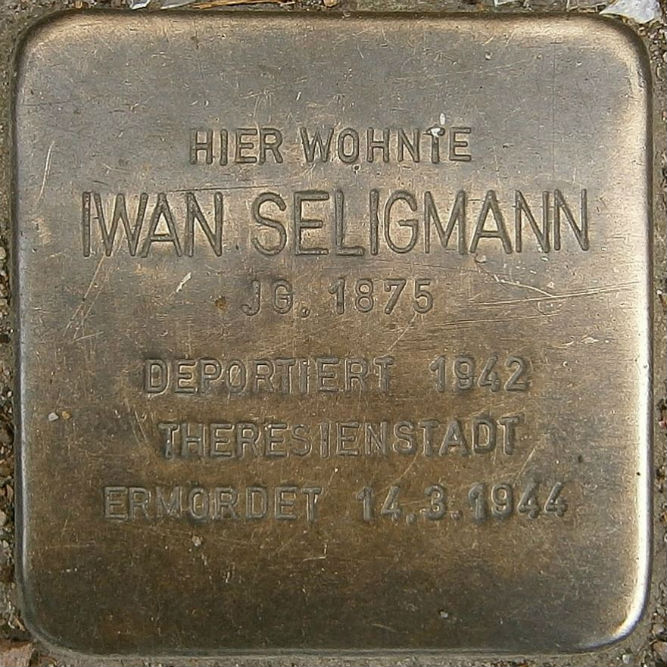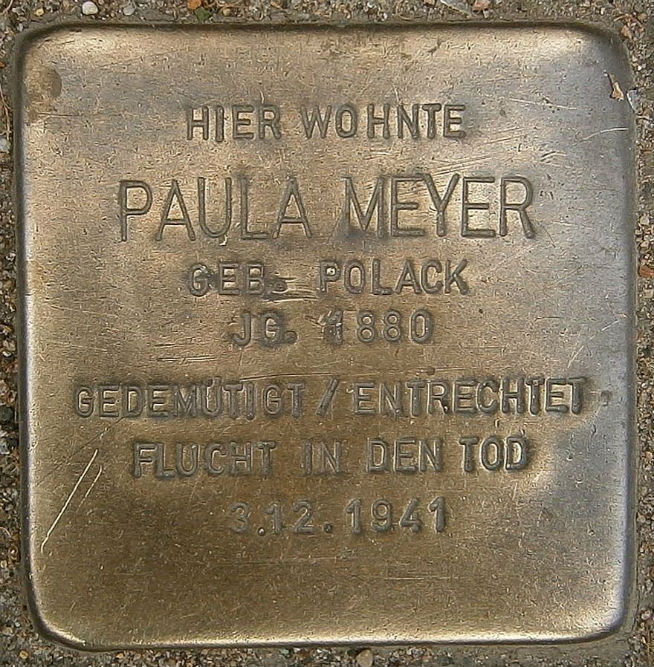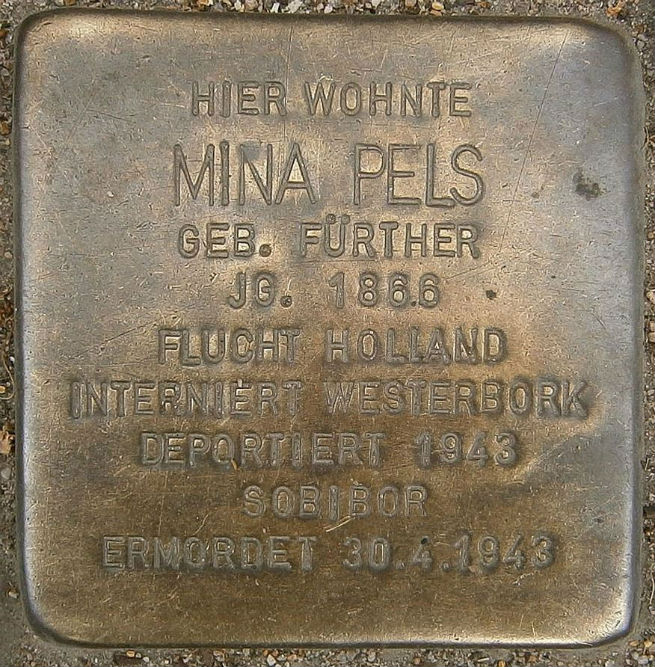Stumbling Stones Isestraße 39
These small brass memorial plaques (Stolpersteine, struikelstenen, or stumbling stones) commemorate:
* Iwan Seligmann, born 1875, deported 1942 Theresienstadt, murdered 14 March 1944.
* Paula Meyer née Polack, born 1880, humiliated / deprived of rights, killed herself 3 December 1941.
* Mina Pels née Fürther, born 1866, fled to Holland, interned at Westerbork, deported 1943 Sobibor, murdered 30 April 1943.
Iwan Seligmann
Iwan Seligmann was born in Hamburg in May 1875. Almost no information was found about his life other than that his permanent residence was Hamburg. Records show that he was deported to Theresienstadt from Hamburg on transport VI/1 on 16july1942. Of the 925 people in that transport, only 41 survived. Unlike many others, he was not deported onward to an extermination camp. Iwan Seligmann was still in Theresienstadt when he was killed. He was 68.
Paula Meyer
Paula and James Meyer married in 1928; he was her second husband, who was in banking. He died in 1937 and left her a substantial inheritance. From October 1939 on, a "security order" was placed on her accounts (a similar situation to that of other Jews), and she received a limited amount of funds each month. In 1940 and 1941, she and her accountant transferred money connected to her open plans to emigrate from Germany. One of these requests was to provide her loyal, live-in maid with a sum that would support her into her own old age.
By mid-November 1941, three deportation trains had already left Hamburg, and no one had returned. Emigration looked impossible. Paula Meyer received her own orders to "evacuate." Rather than go to a concentration camp, she took an overdose of sleeping pills. Her live-in maid found her unconscious and called an ambulance, but Paula died shortly after arriving at the hospital.
Paula’s son from her first marriage, Erwin Franck (b. 1903), emigrated to Denmark in 1933 and survived. Paula’s financial advisor, Morris Samson, made sure that Paula’s maid received the gift from Paula and later assisted Paula’s son with reparations.
Mina Pels
Mina Fürther married Mathias Pels, a private banker, in 1888 and joined him in Hamburg. They had three daughters – Henriette (Henny, b. 1891), Hedwig (b. 1894), and Else (b. 1898). The bank failed at the end of World War 1. Two daughters moved out of the family home at this address to join their own husbands. Mathias Pels retired from work in 1923. Hyperinflation depleted the family’s savings, and they moved to a smaller location. Mathias died in hospital in 1933. Mina and her youngest daughter moved to a number of other places before they fled to Holland in 1939. Mina joined the household of daughter Henny Jochems, now a Dutch citizen. Else, who worked as a housekeeper, lived at another address. The third daughter, Hedwig, had already emigrated to the USA with her husband.
Two years after the Germans invaded the Netherlands, Henny and her family went into hiding. Mina was still at Henny’s address when she was arrested on 17 April 1943, taken to Westerbork, and deported to Sobibor. The Netherlands Red Cross recorded her death as of 30 April 1943. She was 77 years old.
Mina’s two daughters still in the Netherlands were also murdered. On 8 June 1943, Else Pels was deported to Sobibor and murdered there 3 days later. A stolperstein in front of her last Hamburg residence at Willistrasse 1 commemorates her. Henriette (Henny) Jochems, her husband Isidorus, and one daughter Jenny Lucy (b. 1915) were deported to Auschwitz and murdered there on 11 February 1944. Henny and Isidorus Jochem’s other daughter Marion (b. 1920) went into hiding and survived the war.
"Stolpersteine" is an art project for Europe by Gunter Demnig to commemorate victims of National Socialism (Nazism). Stolpersteine (stumbling stones) are small, 10x10cm brass plaques placed in the pavement in front of the last voluntary residence of (mostly Jewish) victims who were murdered by the Nazis. Each plaque is engraved with the victim’s name, date of birth, and place (mostly a concentration camp) and date of death. By doing this, Gunter Demnig gives an individual memorial to each victim. One stone, one name, one person. He cites the Talmud: "A human being is forgotten only when his or her name is forgotten."
Do you have more information about this location? Inform us!
Source
- Text: Fedor de Vries & Anne Palmer
- Photos: Bahnmoeller (1), Hinnerk11 (2), Hinnerk11 (3), Hinnerk11 (4)
- Stolpersteine Hamburg: Paula Meyer
- Yad Vashem Central Database of Shoah Victims’ Names
- USHMM Holocaust Survivors and Victims Database
- holocaust.cz
- Stolpersteine.eu
Nearby
Museum
- Museum Ernst Thälmann - Hamburg-Eppendorf
- Stadthaus Remembrance Site Hamburg - Hamburg
- School Museum Hamburg - Hamburg-St. Pauli
Point of interest
- Former Synagogue Portuguese Community - Hamburg-Harvestehude
- Budgepalais Hamburg - Hamburg
- Curio-Haus - Hamburg
Monument
- Memorial Destroyed Jewish Life - Hamburg-Harvestehude
- Memorial Jewish Retirement Home - Hamburg-Eimsbüttel
- Jewish Memorial St. John's Church Hamburg - Hamburg
Cemetery
- Cemetery for Victims Siege of Hamburg - Hamburg-Altona
- Mausoleum Konrad Daniel von Blücher-Altona - Hamburg-Altona-Altstadt
- Siege Cemetery Hamburg - Hamburg-Barmbek-Süd
Remembrance Stone
- Stumbling Stones Isestraße 41 - Hamburg-Harvestehude
- Stumbling Stones Isestraße 37 - Hamburg-Harvestehude
- Stumbling Stones Isestraße 43 - Hamburg-Harvestehude







